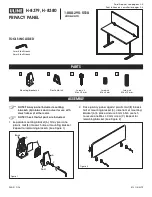
The
DSP7000
Family Operating Manual
Manual Release 1.1
The DSP7000 Family Operating Manual
Page 37
2000 Eventide Inc.
MIDI Setup
In the DSP7000, MIDI can be used:
•
with programs that explicitly call for MIDI signals. For example, some programs in the DSP7000 act
like synthesizers that a MIDI keyboard can play.
•
with programs that explicitly call for some sort of “external” controller. For example, the program “
Ex-
ternal Detune
” calls for an external signal to adjust the amount of detune that is applied to an audio
signal. You can direct a MIDI controller to do the adjusting.
•
to remote control
any
parameter in the DSP7000 (including input and output levels).
•
to change programs via MIDI program change messages.
→
See
Loading A Program Via A MIDI Program Change Message
on page 55.
•
to advance to the next program or select the previous program.
→
See
Triggering the Next or Previous Program To Load
on page 56.
•
to load programs in sequence.
→
See
Triggering the Next or Previous Program To Load
on page 56.
•
to “dump” information from one DSP7000 to another or to an external storage device.
→
See
Dumping Data and Receiving Data Dumps
on page 65.
•
to control one DSP7000 with another.
→
See
Controlling One DSP7000 from Another DSP7000
on page 66.
•
to record parameter changes on a MIDI sequencer for subsequent playback.
→
See
Sequencing With MIDI
on page 67.
There are several MIDI “global” parameters that bear on how all
of the above uses of MIDI function. These parameters are found
on the
midi
menu page in the
SETUP
area (you may have to
press the
S
S
S
E
E
E
T
T
T
U
U
U
P
P
P
key a few times to find it). The
midi
menu
page is “stacked”; the “top” menu page is shown to the right. Let’s look at each parameter in turn, shall we?
MIDI
If set to
disabled
, all received MIDI commands are ignored. However, MIDI
output
messages, including parameter changes, program load, bank change, and the various
dump commands, are still enabled. Set this parameter to
enabled
if you want to
re-
ceive
MIDI messages.
serial
Enables or disables the serial port. If set to
enabled
, MIDI commands can be re-
ceived at or sent from the serial port.
→
See
Setting Up the Serial Port
on page 64.
program load
This determines whether the DSP7000 will accept and obey MIDI program change
messages.
sequence out
If set to
on
, then every time a parameter is changed or a program is loaded, a corre-
sponding message is sent out the MIDI port as a system exclusive message. By re-
cording parameter changes to a MIDI sequencer, you can automate your mixdowns.
Simply play back the recorded MIDI sequence at the DSP7000’s MIDI input, and
you will see the changes you recorded “played” by the sequencer (
assuming
MIDI
is
en-
abled
and
system exclusive
is
on
). However, if you manage to configure the MIDI con-
nections between your various pieces of equipment such that the “system exclusive,
sequence out” MIDI messages of the DSP7000 loop back into the DSP7000 without
delay, digital demons will unleash a raging fury inside your helpless DSP7000. So,
















































